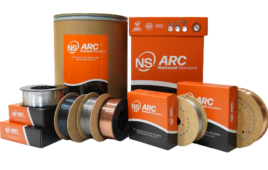Written by Miles Budimir
Senior Editor, WTWH Media
 Like all other welding processes, such as gas, electric arc, and ultrasonic systems, laser welding (or laser beam welding, or LBW) joins two pieces of material together. Materials are typically metals or different types of thermoplastics.
Like all other welding processes, such as gas, electric arc, and ultrasonic systems, laser welding (or laser beam welding, or LBW) joins two pieces of material together. Materials are typically metals or different types of thermoplastics.
Each of these welding methods differs in the heat source that’s used to melt the materials together. For example, a typical gas welding technique is oxyacetylene welding whereas electric arc techniques use electrical energy to strike an arc between an electrode and the material.
Laser welding uses the high energy of a laser beam to melt and then join the parts together. There are a few different laser types including gas sources, such as anitrogen, helium, and carbon dioxide combination, or solid-state lasers such as ND:YAG pulsed lasers. Pulsed lasers are typically used for thinner materials while continuous beam lasers are employed where thicker materials need to be welded.
A typical laser welding setup includes the laser generator and optics to focus the beam. Focusing optics helps to shape the beam to the right size and direct it to the proper spot on the materials to be welded. The fact that the laser beam can be controlled and focused so precisely results in greater power density with less generated heat.
Laser welding has several benefits over other welding methods. For one, weld times are short with fast cooling times. Laser welding also yields a high-quality weld, similar to electron-beam welding. The ability to precisely control and focus the beam leads to clean, precise welds with little “slag” or need for rework or polishing. This is in contrast with other more traditional hand-welding manual processes, like MIG or TIG welding, where the quality of the weld depends on the skill of the welder.
These factors combined make laser welding suitable for automation, leading to high-quality, repeatable, consistent welds. Typical uses include automotive manufacturing and other automated processes that require mass production. As for drawbacks, initial investment cost for equipment may be higher than other types of welding equipment, but this can be offset by the exceptional quality of the welds and high ROI.





Tell Us What You Think!